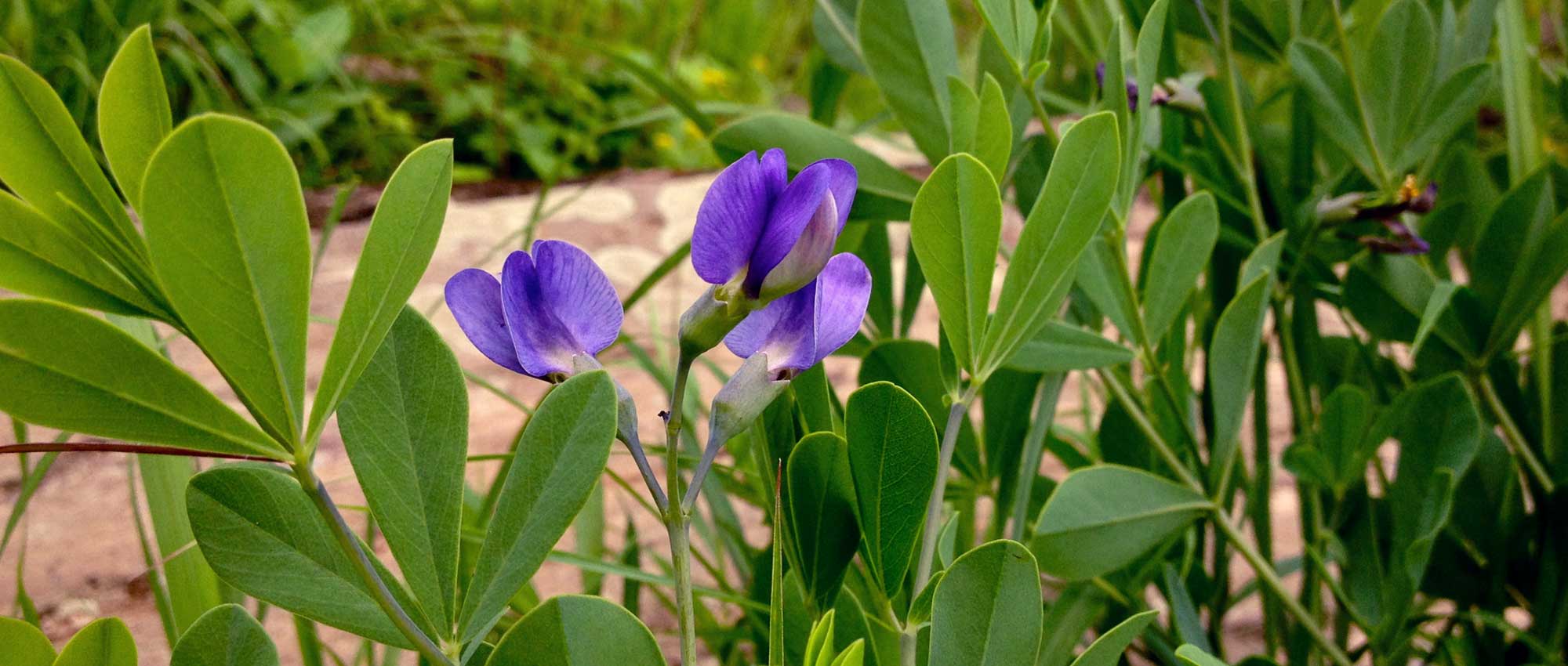
Baptisia or false indigo: sowing, planting and growing
Contents
Baptisia in a nutshell
- Baptisia offers a flowering in long upright spikes, usually blue, resembling lupin flowers.
- There are varieties in white, yellow, chocolate, purple shades…
- With its soft and airy habit, Baptisia adds volume to borders.
- It boasts superb foliage, bluish-green, divided into three leaflets.
- Its fruits are decorative!
- Baptisia requires little: it tolerates poor soils, drought, and is very hardy. Moreover, it is not susceptible to diseases and pests!
- It is a reliable plant, easy to grow and long-lived.
A word from our Expert
Also known as indigo lupin or false indigo, the Baptisia is a lovely voluminous perennial that bears elongated and upright inflorescences, somewhat reminiscent of the flowering of lupins. Its deciduous foliage with a bluish sheen is very decorative! The most commonly cultivated species is Baptisia australis, which has blue flowers. The variety Baptisia australis ‘Alba’ is also appreciated for its elegant white flowering. The flowers can also be yellow, as seen in Baptisia ‘Carolina Moonlight’, or brownish-purple, like the variety ‘Dutch Chocolate’. Baptisia is a good melliferous plant, attracting pollinating insects.
It is a perennial that remains interesting for a long time, as even outside the flowering period, its foliage and the original pods it produces have decorative appeal!
Baptisia is a little-known plant, but it certainly deserves a place in our gardens! It has the advantage of offering superb flowering while requiring almost no maintenance. It will thrive when planted in full sun, in rather dry soil. Rarely diseased or attacked by pests, Baptisia does not require much attention once established. It can be multiplied by sowing.
Botany
Botanical data
- Latin name Baptisia australis
- Family Fabaceae
- Common name Indigo lupin, False indigo, Podalyre
- Flowering between May and July
- Height between 1 m and 1.50 m.
- Exposure full sun
- Soil type draining
- Hardiness -15 °C
The baptisias comprise around thirty species of perennial plants native to North America. These are herbaceous or semi-shrubby plants. The most cultivated is Baptisia australis. It is found in the southern and eastern United States. In the wild, it grows at the forest edge, along waterways, and in meadows.
Baptisia is part of the large family of Fabaceae, like beans, clovers, lupins, or wisteria! Its membership in this family is evident in its leaves (divided into leaflets), its flowers (papilionaceous), and its fruits (pods). This family has the unique ability to fix atmospheric nitrogen, which explains why baptisia tolerates poor soils and does not really need fertiliser!
Baptisia is a perennial plant that grows slowly; it takes time to establish itself and start flowering… But once in place, it lives for a very long time!
The name Baptisia comes from the ancient Greek Bapto, meaning to immerse or dip. This refers to the dyeing properties of the plant, which can colour fabrics if they are dipped in a dye prepared with baptisia. The species name, australis, means “of the South”. Baptisia has various vernacular names: false indigo, indigo lupin, podalyre… It is sometimes called false indigo because it has been used as a substitute for the dye plant Indigofera tinctoria.
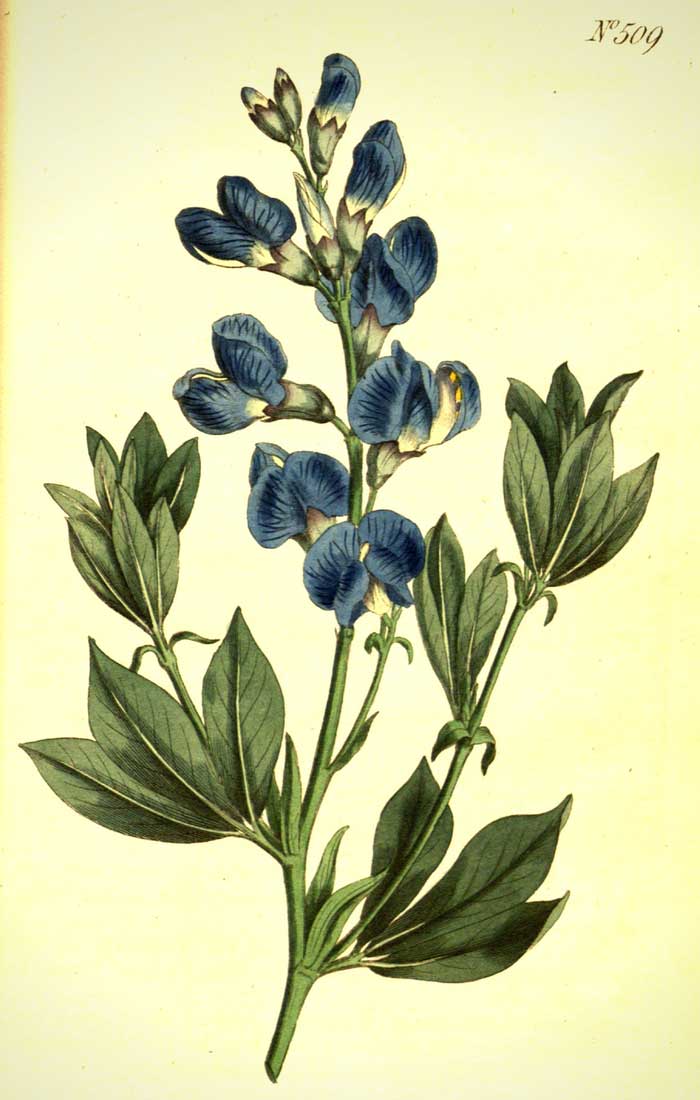
Baptisia australis: botanical illustration
Baptisia forms a large, voluminous clump. It bears tall, upright stems that are very straight. It has a rather free and flexible habit, not too rigid… which allows it to be planted in a naturalistic border! It is quite a tall plant, as it reaches between 1 m and 1.50 m in height depending on the varieties, with a width of 60 cm to 1 m. There are a few smaller varieties, such as Baptisia australis var. minor, which does not exceed 60 cm in height.
Baptisia flowers in late spring to early summer: between May and July, depending on the varieties.
It then offers long clusters of flowers, borne above the foliage, at the tips of upright stems. Its flowering is very similar to that of lupins, as they are closely related plants, but the flowers of baptisia are finer and more flexible, much more airy.
Baptisia is appreciated for its intensely vibrant blue flowers. Those of Baptisia australis range from deep blue to violet. Although this is the most common shade, there are also varieties with yellow, white, purple, or chocolate flowers. The white-flowered varieties have a delicate and very elegant appearance, while the dark, purple-flowered ones add depth and contrast to borders. The variety ‘Sparkling Sapphires’ offers a remarkable flowering of a very intense blue! Sometimes, the flowering is bicolour, as seen in the variety ‘Cherries Jubilee’. The flowers can thus be beautifully edged in yellow or cream.
The flowers of baptisia are papilionaceous and somewhat resemble those of lupin. They measure between 2 and 3 cm in length and are hermaphroditic: they possess both male and female organs. Each flower is attached to the stem by a small pedicel. It is composed of five petals. The upper petal is called the “banner”: it is broad and upright, with a notch in the centre. Two lateral petals form the “wings”, surrounding two closely positioned petals (the “keel”), between which are the reproductive organs: ten stamens and a style. The petals are inserted on a tubular calyx with five lobes (five fused sepals).
The flowering of baptisia is melliferous, attracting pollinating insects (bumblebees, bees, butterflies…).

The flowering of baptisias. From left to right, Baptisia minor (photo Katja Schulz), Baptisia ‘Indigo Spires’, Baptisia ‘Brownie Points’ and Baptisia ‘Pink Truffles’
Even once flowering is over, baptisia remains decorative thanks to its superb soft green foliage, slightly grey or bluish. This provides a lovely backdrop for other blooms in the garden! The leaves are divided into three leaflets… thus, they somewhat resemble those of clover! The divided foliage is one of the characteristics of the Fabaceae family. The leaflets are obovate and slightly wider at the tip. They measure between 2 and 4 cm in length. The leaves are arranged alternately on the stems (one leaf after another).
Baptisia is a deciduous plant. Its foliage and stems disappear in autumn… The plant then goes dormant for the winter!

The foliage of Baptisia australis
Baptisia has a large taproot, which penetrates deeply into the soil. This allows it to withstand drought by tapping into water far below the surface… but also makes its transplantation very difficult. Once established, baptisia does not like to be disturbed. It also has lateral rhizomes, which allow it to spread.
Once flowering is finished, baptisia bears surprising and unusual fruits, which are quite decorative. Belonging to the same family as beans, it produces pods that contain seeds, just like them. In baptisia, the pods are quite short and rounded, swollen. They are pointed at the end with a fine, elongated tip. They are initially green, then turn black when ripe. They then open to release brown, kidney-shaped seeds. The pods can be used to create dried bouquets.

The pods of Baptisia australis (photo R. A. Nonenmacher / photo El Grafo), and the seeds (photo Denis Prévot)
The main varieties of Baptisia
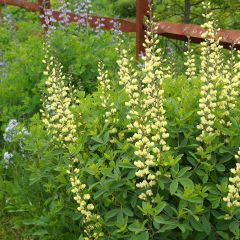
Baptisia Carolina Moonlight - False Indigo
- Flowering time June, July
- Height at maturity 1 m
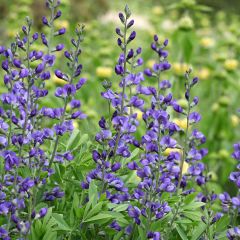
Baptisia australis - False Indigo
- Flowering time August, September
- Height at maturity 1,50 m
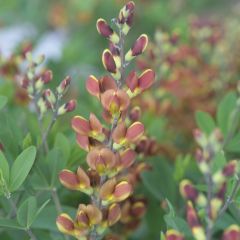
Baptisia Cherries Jubilee - False Indigo
- Flowering time June, July
- Height at maturity 1 m
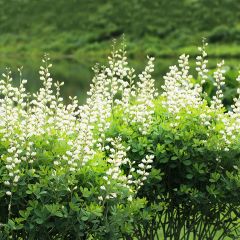
Baptisia australis Alba - False Indigo
- Flowering time June, July
- Height at maturity 1,20 m
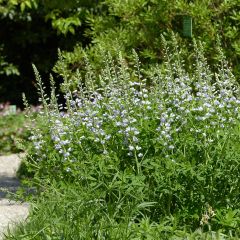
Baptisia australis Starlite Prairieblues - False Indigo
- Flowering time June
- Height at maturity 90 cm
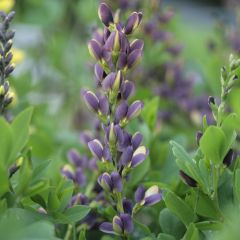
Baptisia australis Indigo Spires - False Indigo
- Flowering time June
- Height at maturity 83 cm
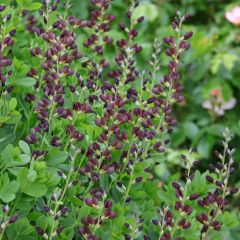
Baptisia Decadence Series Dutch Chocolate - False Indigo
- Flowering time June, July
- Height at maturity 1 m
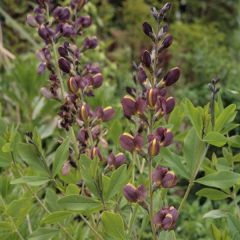
Baptisia Twilight Prairie Blues - False Indigo
- Flowering time June, July
- Height at maturity 1 m
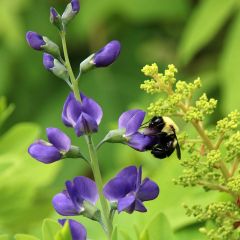
Baptisia Purple Smoke - False Indigo
- Flowering time June, July
- Height at maturity 1 m
Discover other Baptisia
View all →Available in 0 sizes
Available in 1 sizes
Available in 1 sizes
Available in 1 sizes
Available in 1 sizes
Available in 2 sizes
Available in 1 sizes

Available in 2 sizes
Available in 1 sizes
Available in 1 sizes
Planting
Where to plant?
Choose the location of your baptisia carefully: it is a long-lived plant that dislikes being moved. Its deep taproot could be damaged if you attempt to transplant it.
Baptisia needs a bright exposure. It thrives in full sun! It will appreciate having at least six hours of direct sunlight per day. It can tolerate partial shade, but its stems may tend to become longer and more flexible, potentially requiring staking. A sunny exposure will ensure a more abundant flowering and a plant with a rather compact and sturdy habit.
It is important to plant it in draining soil, as it fears winter moisture. You can improve drainage by adding gravel, pumice, coarse sand, or by planting on a mound. Baptisia tolerates stony and dry soils but not excessive limestone.
Baptisia prefers slightly acidic or neutral soils but can tolerate slightly calcareous soils. It enjoys light, loose, and porous soils. It also tolerates poor soils… Especially since its roots, in association with bacteria, have the ability to fix nitrogen.
Baptisia can be planted in a border or a mixed border, in a romantic, naturalistic, or “cottage garden” style… But feel free to also plant it in a Mediterranean garden, a dry garden, or a rockery. It can also help to green up a slope or a difficult area of the garden. It is a robust plant, rarely diseased, and long-lived. For example, it can be planted in poor and dry soil, where other plants struggle to grow. As it requires almost no maintenance, you can place it in a part of the garden where you rarely intervene.
When to plant?
Planting baptisia can be done in spring, around April, or in autumn, in September-October. Avoid intervening during frost or extreme heat.
How to plant?
You can plant baptisia alone or in small groups.
- We recommend starting by placing the root ball in a basin of water to moisten it.
- Then you can dig a planting hole, about twice the size of the root ball. Don’t hesitate to add gravel or coarse sand to facilitate water infiltration, especially if your soil is heavy and clayey.
- Plant your baptisia by placing it in the planting hole.
- Replace the soil and gently firm it around the plant with the palm of your hand.
- Water generously.
We recommend watering during the first year, while it develops its root system.
After that… be patient! It takes time for baptisia to settle in: it will take a few years before it offers its first flowers.
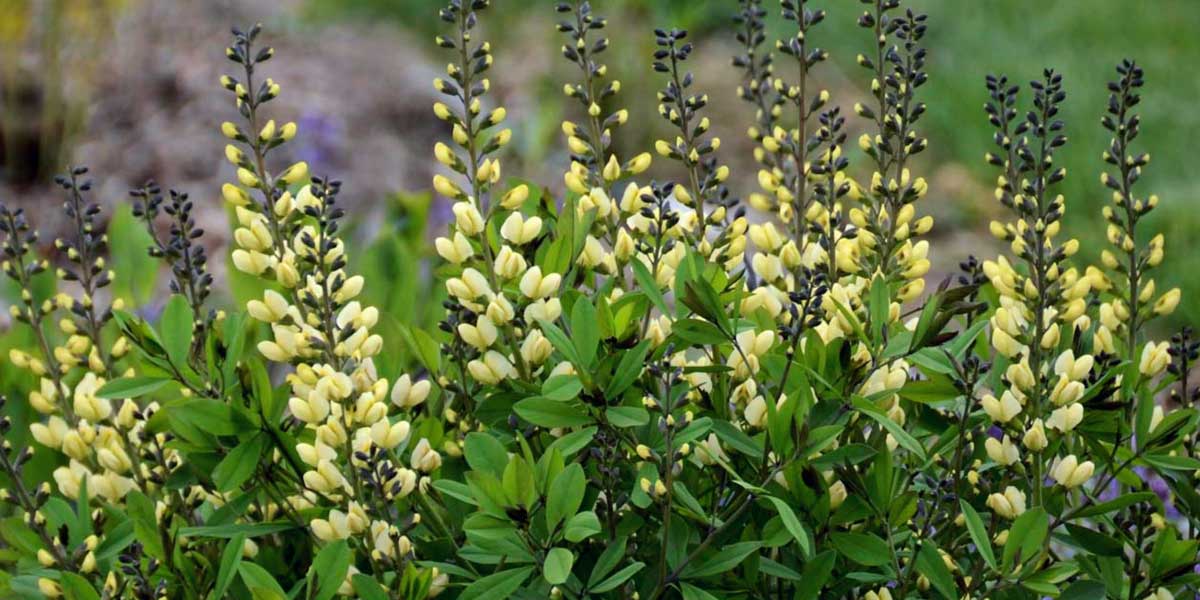
Le Baptisia ‘Vanilla Cream’
Care
Baptisia requires little maintenance. However, we suggest watering it during the year of planting. After that, it will not need watering, as once established, Baptisia becomes truly drought-resistant. Additionally, as it belongs to the Fabaceae family, it has the ability to fix atmospheric nitrogen; therefore, it does not need fertiliser!
Baptisia will appreciate it if you install a layer of mulch at its base.
You may choose to cut the faded flowers, but we suggest leaving them on the plant instead, to allow Baptisia to produce pods, which are unique and have decorative interest.
If you have planted your Baptisia in a slightly shaded position, it may require staking to prevent the stems from flopping.
With the first frosts, the foliage dries and becomes unsightly. It is best to cut back the plant in autumn.
Baptisias are not particularly susceptible to diseases and pests. They are hardy and therefore do not need to be protected from the cold in winter.
Multiplication
We recommend propagating baptisia by sowing, although it is also possible to divide the clumps, but this technique is very delicate.
Sowing
You can sow the seeds produced by your baptisia. To collect them, wait until the pods turn black and start to open. You will achieve better results by sowing the seeds as soon as they are harvested in autumn. Indeed, when they are still fresh, their seed viability is greater. It is also possible to sow the seeds in late winter to early spring, but in this case, store them in the refrigerator in the meantime.
The seeds are a bit tricky to germinate, as their outer shell is hard and thick, which prevents water from reaching the seed and limits gas exchange with the outside. To remedy this, you need to scarify the seeds (by rubbing them with sandpaper or making incisions with a knife), or soak them in hot water for a few hours.
- Place the seeds in hot water and leave them for 24 hours to soften their outer shell.
- Take a pot and fill it with special sowing compost, then gently firm it down.
- Sow the seeds on the surface.
- Cover them very lightly.
- Water with a fine spray.
- Place the pot under a frame, in a bright location, ideally at a temperature of around 20 °C.
Continue to water regularly to keep the substrate slightly moist. The seeds take between 2 and 4 weeks to germinate. You can transplant the young plants in spring. You may have to wait three years before your baptisias start to flower! But once established, they can live for several decades.
Association
Baptisias are perfect for incorporating into a cottage garden. Opt for soft, pastel shades: install plants with sky-blue, white, soft pink, salmon, and orange flowers… For example, choose campanulas, foxgloves, delphiniums, white-flowered lupins, star-of-Bethlehem, or centauries. Also, opt for plants with well-developed, light green foliage. To maintain a delicate atmosphere, you can use baptisias to create a romantic-style garden. Integrate them with bleeding hearts, roses, gypsophila, oriental poppies… Prefer white and soft pink, or even mauve flowers.
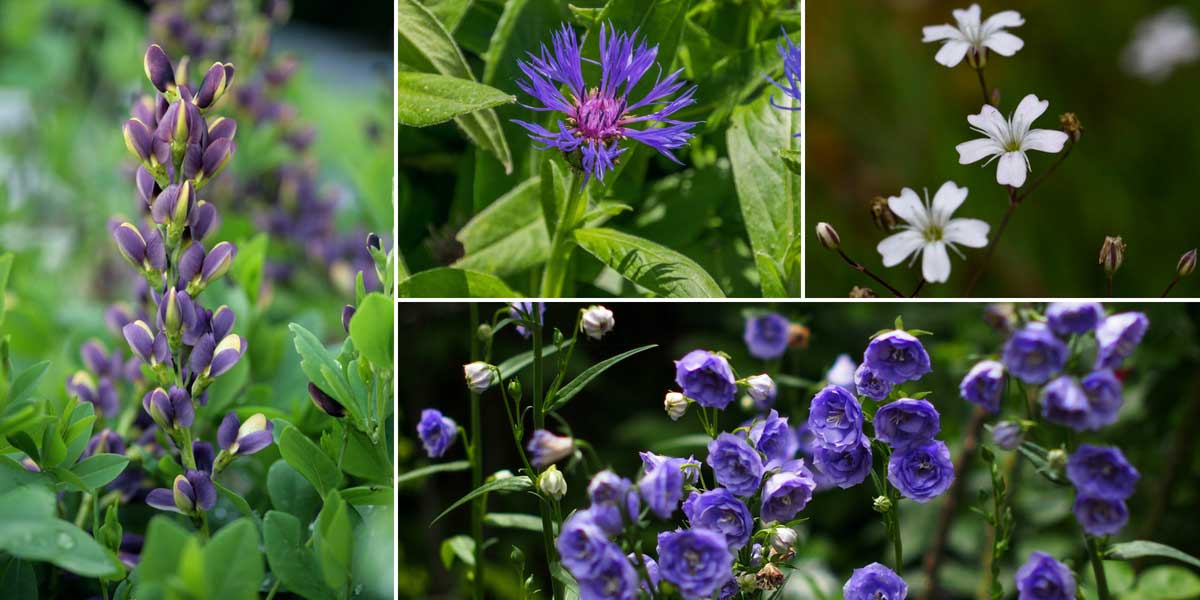
Baptisia can be combined with other delicate flowers, in blue and white tones, for example, to create a “cottage garden” style bed. From left to right, Baptisia ‘Indigo Spires’, Centaurea montana (photo Krzysztof Golik), Gypsophila repens ‘Alba’ (photo Thomas Ripplinger), and Campanula persicifolia ‘La Belle’ (photo Takashi M)
Baptisias will also find their place in a colourful mixed border, alongside other perennials offering generous blooms. You can pair them with ornamental Alliums, coreopsis, lady’s mantle, or camassias.
With its long flower spikes and fairly loose habit, baptisia is an ideal plant for wildlife gardens, with a natural style. Its airy and light flower stems will beautifully accompany the delicate flowers of Buenos Aires verbena or sages (notably Salvia nemorosa)… Mixed with the fine foliage of grasses, and other small colourful flowers (cornflowers, poppies, meadow sages…), baptisia can be integrated into a flowering meadow! Your garden will benefit from a very natural and free aspect. Don’t hesitate to create contrasts with other areas that have a more maintained and rigid appearance.
Since it tolerates drought well, poor, stony soils, and enjoys full sun, you can incorporate it into a dry garden, in a Mediterranean style, or in the background of a rockery… Plant it with sages, enjoy the graphic forms of Verbascum and the yellow inflorescences of Phlomis fruticosa, not forgetting the downy foliage of Stachys byzantina!
Useful resources
- Discover our range of baptisia!
- Our advice sheet: Baptisia the most beautiful varieties
- Our advice sheet on slow to establish plants
Frequently asked questions
-
My baptisia isn't flowering... Why?
Baptisia requires patience: it may take several years before it is well established and starts flowering. But once in place, it can live for a long time without needing special attention! The flowering of baptisia is more generous when it is in full sun rather than in shade. Make sure its location is sunny enough!
- Subscribe!
- Contents
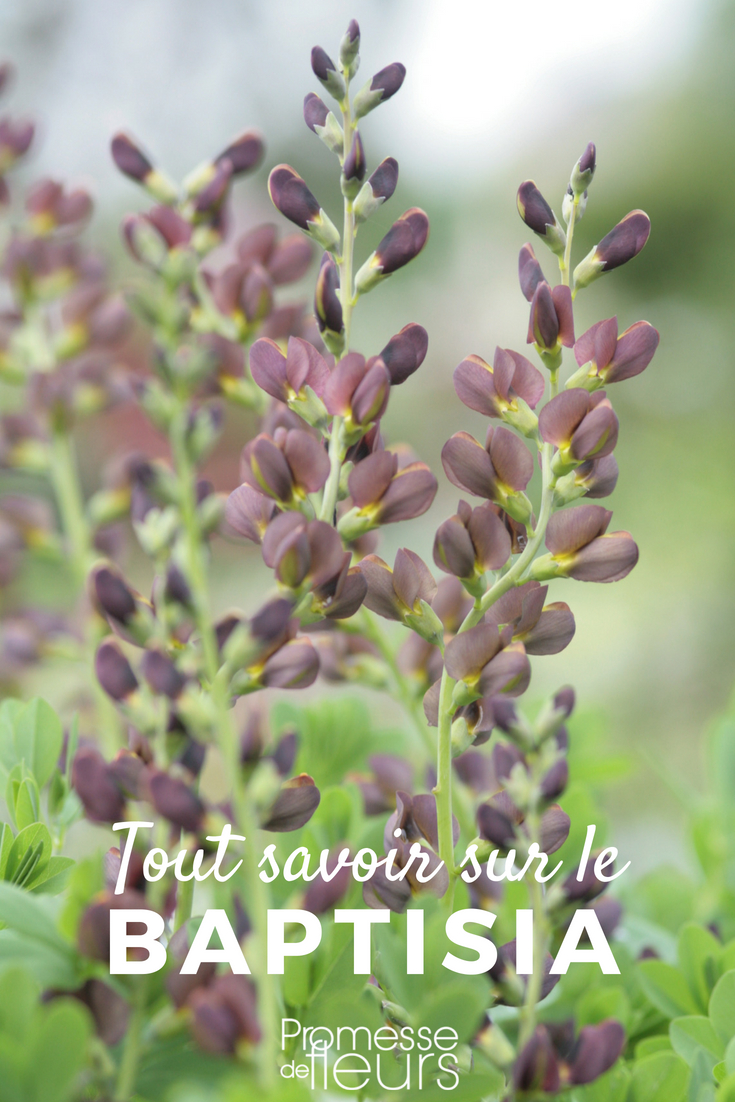































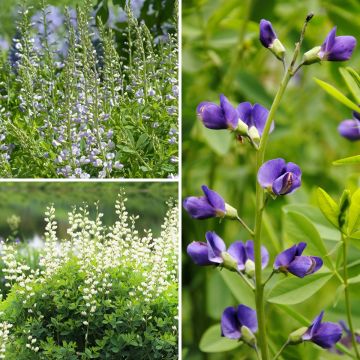
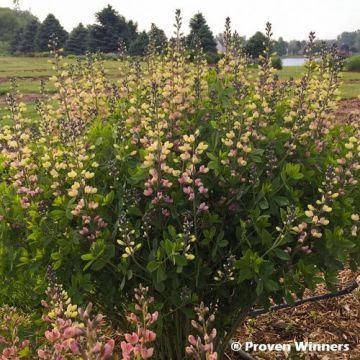
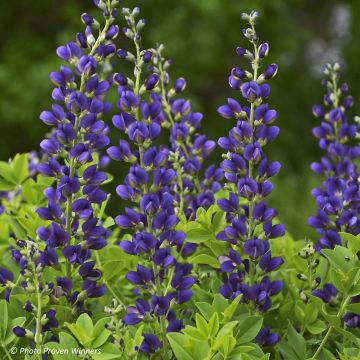

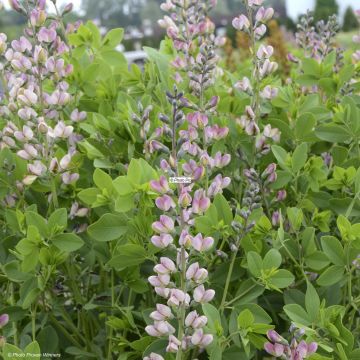
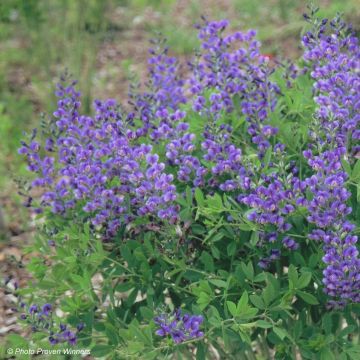
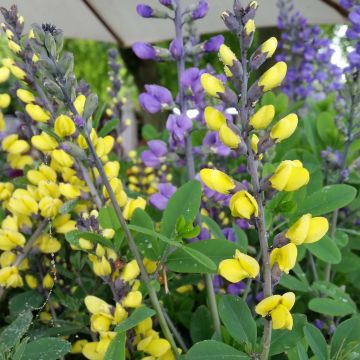
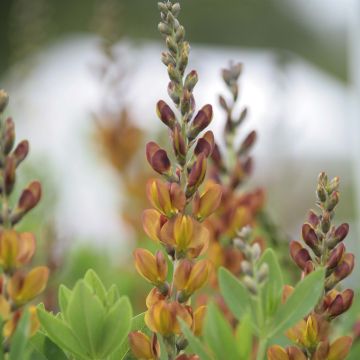
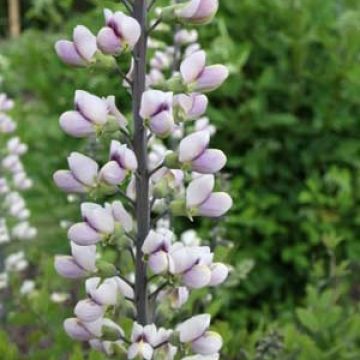
Comments